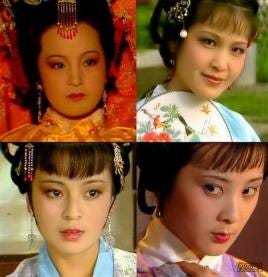Is It Really Fate?
We noted yesterday that the names of the four Jia girls form a meaningful phrase.
If you take the given names of 賈元春 (Jia Yuanchun), 賈迎春 (Jia Yingchun), 賈探春 (Jia Tanchun), and 賈惜春 (Jia Xichun), and put them together, you get 元迎探惜 (yuan ying tan xi).
Now, we know from our earlier explorations in Dream of the Red Chamber that almost every single name in the novel stands for something else. You see, the Chinese language has so many characters that just about all of them are homophones with some other character. And so, if you’re a masterful writer, you can use one name to stand in for another name.
We happen to know exactly which characters Cao Xueqin was thinking of here, too.
You might want to take a minute or two to review this post on the original Chinese versions
of Dream of the Red Chamber:
Remember that the version we’re translating comes from the version published in 1792, which happens to be the version used for all basic editions of the book published in both China and Taiwan up to this day.
There are earlier versions of the book out there, of course. A different version was published in 1791, though everybody seems to prefer the 1792 edition. Additionally, incomplete handwritten versions of the text have spread around since the 1750s, a number of which remain extant today.
Some of those handwritten copies include notes written by hand in red ink. Most of these come from the famous pseudonym 脂硯齋, often referred to as something like “Red Inkstone” in the few English works that dig into the textual criticism of Dream of the Red Chamber. Many speculate that “Red Inkstone” was a relative of Cao Xueqin, or perhaps even his father. You might also wonder if it wasn’t Cao Xueqin himself.
We’re not going to deal too much with the intricate details of that level of textual criticism now, however. We’ll worry about that once we’ve finished the book. It’s easy to get lost in the maze of textual history and wind up missing the message of the book itself.
However, Red Inkstone (脂硯齋) tells us in his comments what the names of these four girls stand for. It’s simple: he writes “原也”、“應也”、“嘆也”、and “息也.” 元 and 原 are both pronounced “yuan,” 迎 and 應 are both “ying,” 探 and 嘆 are both “tan,” and 惜 and 息 are both “xi.”
Stick all four together and you have the phrase 原應嘆息: “From the beginning, we should have sighed [at their fates.]”
But does this mean Cao Xueqin was hopelessly fatalistic?
Keep reading with a 7-day free trial
Subscribe to Dream of the Red Chamber to keep reading this post and get 7 days of free access to the full post archives.




